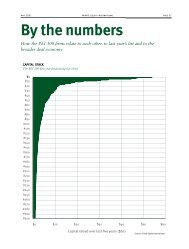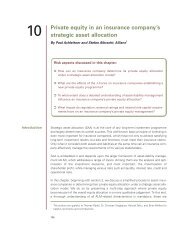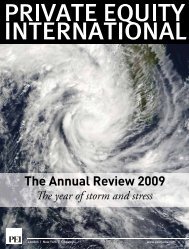Fundamentals of Private Equity and Venture Capital - PEI Media
Fundamentals of Private Equity and Venture Capital - PEI Media
Fundamentals of Private Equity and Venture Capital - PEI Media
You also want an ePaper? Increase the reach of your titles
YUMPU automatically turns print PDFs into web optimized ePapers that Google loves.
GETTING THE MOST OUT OF THIS MODULE<br />
Welcome to Module 9 in the <strong>Fundamentals</strong> <strong>of</strong> private equity series. This module<br />
focuses on private equity secondaries <strong>and</strong> their alternatives. It is designed to<br />
work both as a st<strong>and</strong> alone section <strong>and</strong> as part <strong>of</strong> the whole series. The module<br />
necessarily draws upon topics reviewed in earlier modules, <strong>and</strong> seeks to avoid<br />
repetition <strong>of</strong> their content. However, for the benefit <strong>of</strong> the st<strong>and</strong> alone reader,<br />
a comprehensive glossary has been incorporated, which explains the background<br />
<strong>and</strong> use <strong>of</strong> private equity terminology. All terms which may require<br />
explanation or expansion are printed in bold, to indicate that there is a glossary<br />
entry for them.<br />
In any market, secondary activity is driven by<br />
three major factors: volume in the primary market,<br />
investment structure, <strong>and</strong> transparency.<br />
Issues with all <strong>of</strong> these factors mitigated against<br />
the development <strong>of</strong> a strong secondary market<br />
in private equity until the last decade, when the<br />
growth <strong>of</strong> straight secondary sales <strong>and</strong> the creation<br />
<strong>of</strong> liquidity alternatives exploded. Even<br />
though institutional private equity vehicles<br />
have existed since the 1940s, the volume <strong>of</strong><br />
activity in the primary market did not warrant<br />
an institutional approach to secondary activity<br />
until the mid-1980s, <strong>and</strong> only in the late 1990s<br />
did the primary market really begin to dramatically<br />
exp<strong>and</strong>.<br />
What drives the need for liquidity?<br />
Before delving more deeply into history, however,<br />
it is useful to address participant motivations.<br />
Exhibit 1 summarises briefly buyer <strong>and</strong><br />
seller motivations. While some circles may still<br />
stigmatise fund managers whose fund has been<br />
sold, most transactions are driven by the strategic<br />
needs <strong>of</strong> the seller. In fact, in dollar terms,<br />
most transactions have been driven by large<br />
financial institutions – such as banks <strong>and</strong> insurance<br />
companies – who have decided that private<br />
equity is not a core business <strong>and</strong> who use<br />
the secondary market to exit private equity<br />
entirely, with the goal <strong>of</strong> redeploying capital<br />
into core business lines. Recently, more activity<br />
has been driven by institutional investors seeking<br />
to rebalance their portfolios.<br />
It is also important to note the buyer’s motivation.<br />
Increasingly, investors with a long-term<br />
commitment to private equity seek to purchase<br />
positions in specific funds in order either to<br />
develop a relationship with a fund manager<br />
to gain access to future funds being raised,<br />
or to strengthen a relationship with a the man-<br />
Exhibit 1: Summary <strong>of</strong> buyer <strong>and</strong> seller motivations<br />
Why do institutions sell existing<br />
private equity positions?<br />
Most <strong>of</strong>ten, sales <strong>of</strong> private equity funds are driven by<br />
the internal motivations <strong>of</strong> the seller <strong>and</strong> not<br />
performance issues. Reasons for selling include:<br />
• Inability to fund future commitments<br />
• Need for current cash<br />
• Shift in institutional strategy away from private<br />
equity or long-term assets in general<br />
• Need to rebalance portfolio allocations between<br />
private equity sub-sectors<br />
• “House cleaning” <strong>of</strong> stub positions or problem<br />
funds that will not be supported in the future in<br />
order to decrease administrative burdens<br />
Why do institutions buy secondary<br />
private equity positions?<br />
Institutions purchase secondary positions for a variety<br />
<strong>of</strong> reasons given their strategic goals:<br />
• To generate returns based upon the cash flow<br />
potential <strong>of</strong> the portfolio<br />
• To gain access to future funds to be raised by the<br />
general partner <strong>of</strong> the fund being purchased<br />
• To minimise the J-curve impacts on an<br />
overall portfolio<br />
• To rebalance portfolio allocations between private<br />
equity sub-sectors<br />
• To add vintage year or sector diversification to<br />
a portfolio<br />
COPYING WITHOUT PERMISSION IS UNLAWFUL<br />
THE FUNDAMENTALS OF PRIVATE EQUITY 5

















